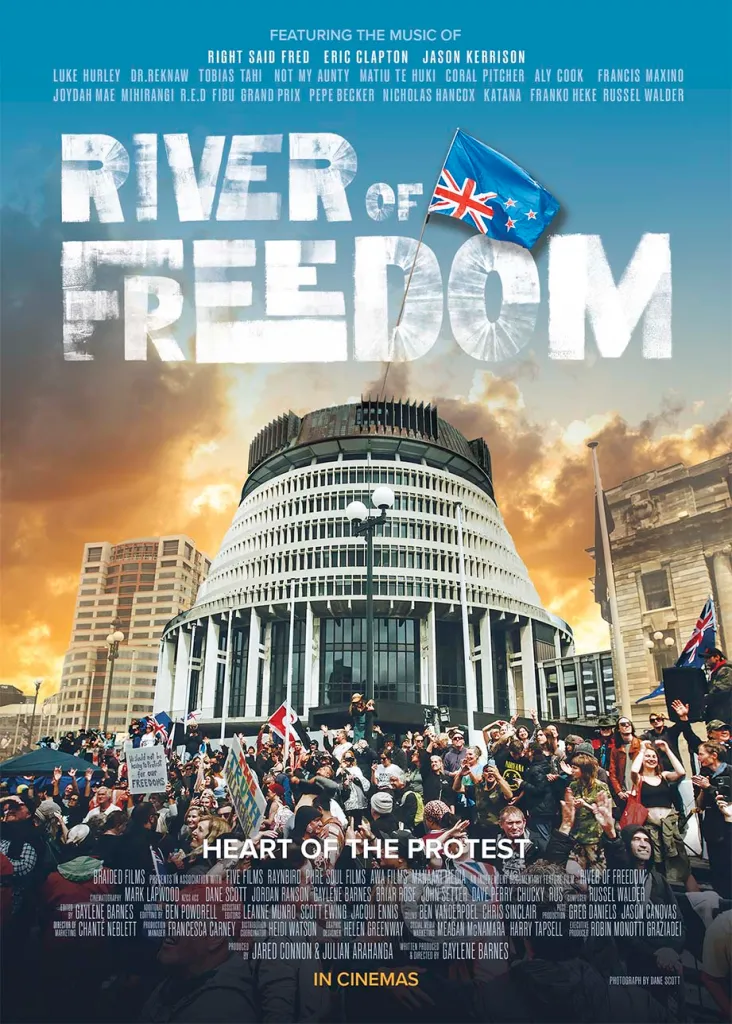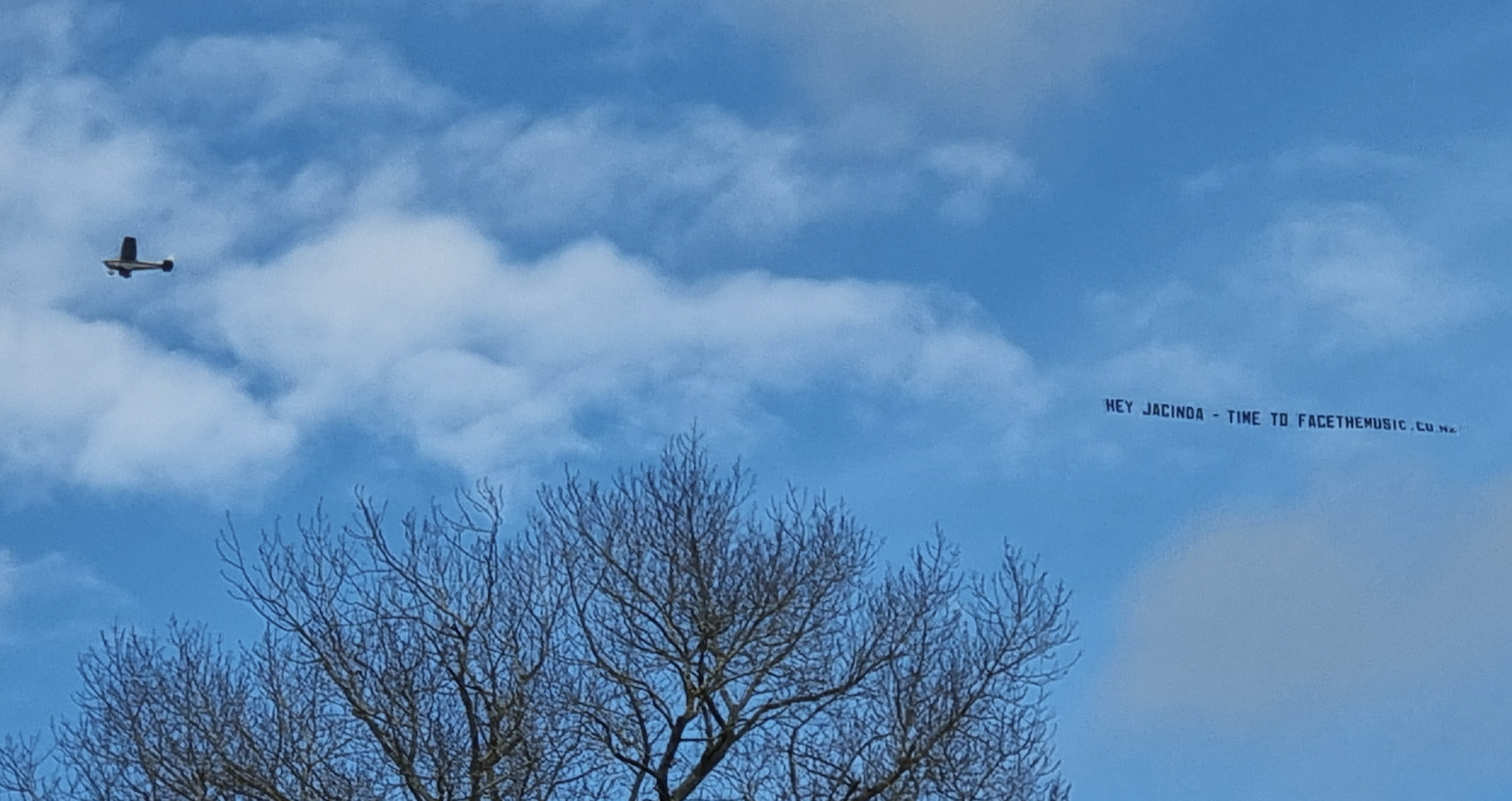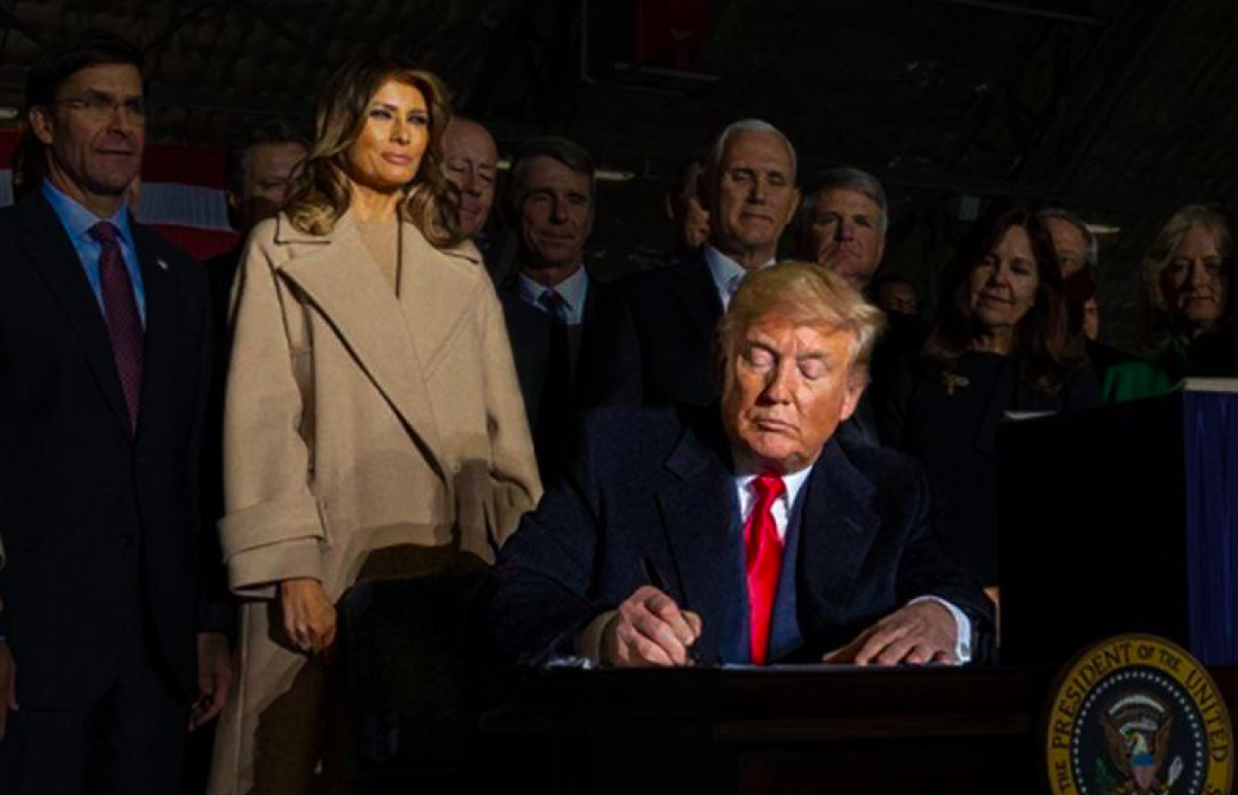
RIVER OF FREEDOM
A review of its opening night in Auckland, 5th September, 2023
by Mike Bee
There must have been close to 2,000 people in the Civic Theatre in Downtown Auckland last night for the world premiere of River of Freedom, the film about the Wellington Occupation of February and March 2022. As I walked home alone along wet Auckland streets, I asked myself if any film had moved me so much and stirred me so deeply over a sustained period of time. I really could not think of one.
It was not only the film; it was not only the memories it stirred. It was the unity and camaraderie that could be felt among that large audience as we laughed and cried together in the dark at what we were seeing. The film is long for a documentary – 2 ½ hours – but it holds us in its grip all that time. There, in that wonderful old building that was itself an echo of an earlier piece of New Zealand’s history, the barriers between people seemed to dissolve; we entered into what we were seeing not merely as spectators but as actors ourselves. Our feelings merged, and we created and became a part of the weaving tapestry of this most extraordinary chapter of New Zealand history.
Sometimes I had to look away from the screen and take a peak at those sitting beside me and around me in the darkness. Some of them had been in this Camp themselves; some had not. Some had gone through experiences similar to mine and some were seeing the film with no previous knowledge. Some would have taken the medications, falsely called vaccines, in order to keep their jobs, while some would have been forced out of their employment. Many of us had experienced rejection from family members and friends. There would also be in that audience a number who had been injured by the enforced medical intervention. All of us had been affected personally in one way or another by what had happened, and we all had our stories of that time. Now we were together, sharing something of great importance, living together this unique account of a very unique event.
The film starts in the misty morning half-light of Cape Reinga, where people are slowly gathering and a Maori prayer of blessing is given. It then follows the journey of the growing convoy as it makes its way south to Wellington. Meanwhile, another convoy travels up the South Island from Invercargill. As we share the two journeys with those New Zealanders in their cars and trucks or stand in the rain cheering them on at the edge of the road or on bridges above, we share in the rapport between those in vehicles and those lining the roads – we experience the hopes and yearnings of people who had suffered greatly but who were now grabbing at the chance to set things right by going to Parliament to have a korero with their leaders. Sitting in the cinema, we could feel again the huge significance of the hour that we had felt at the time. Those in cars and by the roadside knew that history was being made but didn’t know how it would end. The opening of the film captures most eloquently a moment that will never come again to this country but has undoubtedly left a huge impression upon it.
River of Freedom has been crafted from the videos of many different persons. It follows a roughly chronological account of the Wellington Occupation from the start of the convoys to their arrival in Wellington, the first speeches and the erection of the first tents and structures. Then come the events of February 10th when the police unsuccessfully tried to evict those present and the extraordinary scenes of the rain, wind and storm during Trevor Mallard’s futile attempts to drive us out by turning on the sprinklers and playing looped music through the night – something that might have continued longer if it hadn’t disturbed the neighbours. We revel in the courage, determination, perseverance, agility and sense of fun of those who were there and who held onto their goals with a resolve that could not be crushed. When the sun comes out after the night of rain, we feel with them the blessedness of a first series of trials passed and live again how it was for them to be no longer attacked and to feel empowered to grow organically the community they had been secretly carrying in their hearts. People continue to arrive, more elaborate structures are put up and, as if by magic, a place of new spirituality and culture is created.
But the film also jumps outside of the Camp and back in time. We witness key speeches in Parliament by politicians who contributed to the imposition of the mandates, and we are present at Jacinda’s dreadful press conferences. These are painful to watch, but it is also a deeply satisfying experience to share in the spontaneous howls of ridicule and disgust as Jacinda and Chris Hipkins strut with self-importance before the media and give their ridiculous pronouncements as if “science” is speaking through them. This is not an audience who behave as if it will be voting Labour! Jacinda gives her “single source of truth” speech, and, contrasting with the beauty of what is being created on Parliament grounds, we see again the infamous Michael Wood harangue in Parliament of a “river of filth” which gave the film its title. At times, it is like being in a melodrama – we clap and cheer our heroes and loudly boo those evil villains, the politicians. Seeing clips of these politicians next to the New Zealanders whom they lorded over and ignored is a shocking depiction of two different kinds of kiwi values. We live again the outrage that not a single one of those 120 politicians came down to speak to us the entire time.
The film is a study in the contrast of two New Zealands. Jacinda’s legacy, which will have to be healed in future years, is that she divided this country as it has never been divided before. Most of what we see is from the world of those believers in freedom and individual sovereignty, and when the other New Zealand is shown alongside it, the contrast is stark and jarring. A few figures who could be politicians or consultants, shielded and anonymous, watch from above in the Beehive, and we sense their animosity. The journalists, who never go out to speak to their fellow Kiwis, follow what is happening like birds of prey from the balcony. When one journalist does go out among the protestors, she is an alien from a different world, masked and asking questions that are blatant attempts to stir antipathy and elicit soundbites that can be used against the people. Through all of the film, we see the haunting presence of the Beehive itself. In many different moods and from all different angles, it becomes a symbol of what we the people are fighting against, standing there like a fortress whose presence constantly reminds us of what wickedness and plotting might be going on inside it.
The film is a masterpiece in the craft of editing, colour-grading and soundscape. The crew shot much of the Wellington footage as well as the interviews taken after the event in different locations. Onto this is grafted a rich mixture of different videos from many other sources. And yet the final result is seamless in how it unfolds, as if one person had been filming everything. The director, Gaylene Barnes, has headed a team which has worked in the spirit of the Camp, leaving aside their own views, to let the multiplicity of life speak through their film. They have created something that does justice to the depth of what took place. These carefully arranged sequences – juxtaposing different viewpoints, moments in time and locations – are a most important historical record.
The ultimate fate of the film in New Zealand will probably depend on whether freedom or tyranny is the victor in the contest that at this point has only played out some of its early scenes. If New Zealand becomes a full totalitarian state, the film will be banned and confiscated, but if we come through and arise one day as a mature and sovereign nation – with qualities, it is to be hoped, that resemble what were born in the social processes of Freedom Village – it will be compulsory viewing for all high school students for generations to come. May future Kiwis learn from it of the struggles to guard against tyranny. And may we all find strength in it for our personal healings and for the healing of the nation.
As I watched, I became more and more aware that, before this film could end, we had to go through the events of March 2nd and the terrible ending of the Camp. The Camp’s demise is shown in a way that lets one share in what it was like to be there. Firstly, one participant speaks of some omens she has that make her see how it must end. Then, before dawn and in darkness, the first police foray swings into action. The police are relentless; their masks and helmets dehumanize them and cut them off from any emotions. On February 10th the police had been aggressive, but, in front of the TV cameras, their violence was restrained. On March 2nd the gloves were off, and riot shields and pepper spray were used as weapons. There is an an awful inevitability in the unstoppable progression of the police and their chants of “Move, move, move!” Masked and inoculated from any feeling for their fellow-Kiwis, they are intent only on their collective mission to clear the grounds. At the end, the police use rubber bullets. The LRAD acoustic weaponry that they have admitted using is not shown.
And so the thriving and vibrant settlement, unplanned but showing an organic lawfulness as if it was the embodiment of a higher will, was destroyed. Smoke billows around the Beehive. Three kaumatua refuse to be moved and stay there with quiet dignity. One of these describes how, after all was done, Trevor Mallard himself appeared on the scene. He walked around, looking at the devastation that his orders had caused, and, as he looked, repeatedly he laughed. Ardern, Bloomfield and Hipkins may have been the orchestrators of the overall crisis, but Mallard is the one who bears the greatest personal responsibility for all that happened at Parliament. When I heard about him taking pleasure in destruction like that, the word “psychopath” came involuntarily out of my mouth.
We have picked ourselves up from the inevitable tragic demise of the Camp, and we are ready for what the future will bring. Looking back via this film at what has happened brings both pain and joy. When it finished the audience rose spontaneously to give it a standing ovation.
River of Freedom travels from here to Wellington and Christchurch in subsequent evenings. If you get a chance, you must see it. Whether or not you were one of those who was there at the Occupation, it is your story. Whether or not you still feel in yourself wounds opened up by the tyranny of the mandates, watching it will help to make you whole. I believe it will one day be recognized as an important contribution to the history of New Zealand.
.
.
River of Freedom is SOLD OUT for its next performance in Christchurch tonight, 6th September. It will play the following night on 7th September in Wellington and at many other centres around New Zealand after that. Go to the website at https://riveroffreedom.nz/index.php/screening/ for locations, dates and times.
There is a very fine thirteen-minute trailer for the film at https://riveroffreedom.nz/index.php/video/
.
.
Look for more articles by Mike Bee on political and spiritual themes. Subscribe for free to receive them as they are written at michaelburton999.substack.com or follow on counterspinmedia.com/blog
Please pass all Counterspin articles on to those you think would appreciate them but will not come to them without your assistance. We are creating the new world, and it begins with honest human interaction and the sharing of ideas.
-
-
Wednesday - September 6, 2023 - New Zealand
(125) - NZ Freedom Movement
(74) - NZ Government
(86)




Leave a Comment